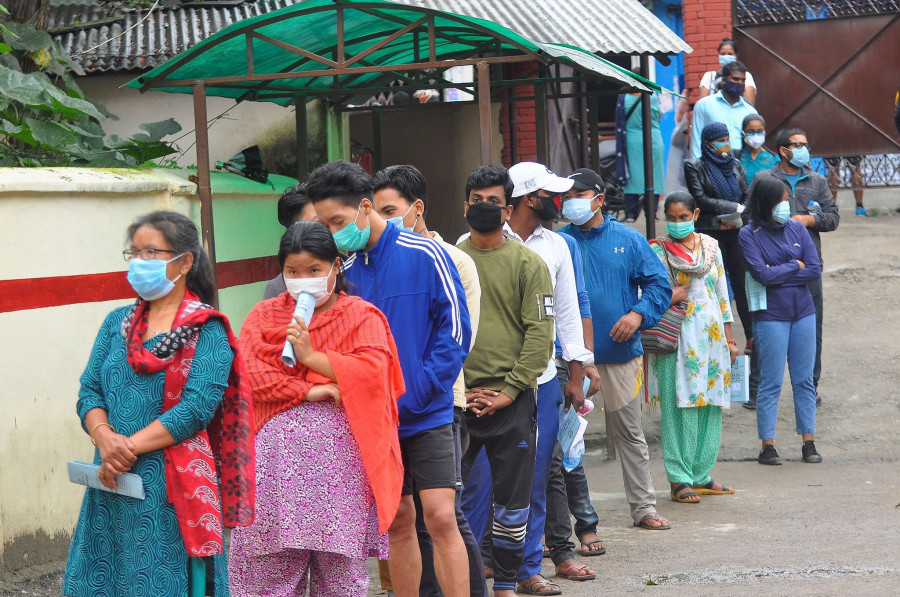Valley
Government decision to keep asymptomatic patients in home isolation raises fear among city residents
The decision came after a surge in the number of active Covid-19 cases across the country, resulting in a shortage of isolation beds in hospitals.
Shuvam Dhungana
Ojir, 37, is one of the 42 Covid-infected persons in Kathmandu Metropolitan Ward No. 32 currently in home isolation.He and his family had tested positive for Covid-19 on August 13.
But isolating at home is not easy for Ojir, who lives in a rented flat in Koteshwor with his family of six.
“Due to a lack of quarantine centres and hospital beds, we have to stay isolated at home as instructed by local authorities. It’s scary because we are not getting any treatment nor are we getting food and essentials from local authorities or the government,” said Ojir, who wished to identify himself only by his first name.
According to Ojir, he and his family went to Teku Hospital to get tested for Covid-19 after another person in the same house was found to be infected.
“My family and I haven’t shown any symptoms so far, but we are really scared, as no one has come to check on our health conditions,” Ojir said. “The last call that I got from a health worker from Kathmandu Metropolitan City was nearly a week ago and there has been no followup since then.”
Ward No. 32 is one of the hardest hit wards in Kathmandu Metropolitan City by Covid-19, with a total of 96 people infected so far. Out of the 92 infected, 42 are getting treatment in various hospitals, 47 are kept in home isolation and the remaining six have already been discharged from hospitals, according to ward member Hira Devi Pokharel.
On Thursday, a Cabinet meeting had decided to hospitalise only symptomatic patients while asymptomatic patients would be asked to isolate at home. Finance Minister Yuba Raj Khatiwada, also the government spokesperson, made the decision public during a press meet in Kathmandu on Friday evening.
The decision of the government to not hospitalise asymptomatic Covid-19 patients has created fear among many people living across the Valley, especially among those who live in cramped spaces. They are worried that if they test positive for Covid-19, they would have to stay in home isolation, exposing their family to the virus.
“A man from another flat of the house we live in got infected but he was told to isolate at home. It was only after he started showing symptoms that he was admitted to a hospital,” said Ojir. “If the person was taken to a hospital immediately after testing positive, my family and I wouldn’t have gotten infected.”
The government decision came after a surge in the number of active Covid-19 cases across the country, resulting in a shortage of isolation beds in hospitals. The country has so far reported 31,117 Covid-19 cases—2,453 in Kathmandu alone, making it the district most affected by coronavirus in the country.
According to Maiya Saiju, a health worker at Kathmandu Metropolis, the city has assigned 10 dedicated teams of 4-5 members for contact tracing and keeping records of infected persons in home isolation.
“When a person tests positive in Kathmandu, we get details about the patient from the Epidemiology and Disease Control Division under the Ministry of Health and Population,” said Saiju. “Then we contact them and ask about their symptoms.”
According to Saiju, if an infected person and their family do not show any symptoms, the health team does not test all of them. They are simply asked to isolate at home by health workers, who check on their health condition from time to time through a phone call, she said.
Due to a lack of isolation beds in Kathmandu Metropolis, managing infected people has become one of the major challenges in the fight against Covid-19, said Saiju.
“We have stopped contact tracing, as Kathmandu lacks isolation and quarantine facilities. We don't have any option rather than telling infected people to stay in home isolation,” said Saiju. “We have been requesting the government to address the problem.”
However, Dr. Jageshwor Gautam, spokesperson for the Ministry of Health and Population, claimed that they are only keeping those people in home isolation who have seperate rooms and toilets.
“Those who do not have such facilities are kept in an isolation centre,” Gautam told the post.
According to Ishwar Man Dangol, spokesperson for the Kathmandu Metropolitan City, there are currently no isolation centres in the city.
“However, the government is planning to construct a 6,000-bed isolation centre in Kathmandu to keep the infected people who do not have the means to safely isolate at home,” said Dangol.
Meanwhile, Ojir from Koteshwor says he and his family have been staying in and drinking turmeric hot water in hopes of recovering from the virus.
“We are very confused. We don’t know what else to do or how long we will have to be in home isolation,” he said.




 9.12°C Kathmandu
9.12°C Kathmandu









%20(1).jpg&w=300&height=200)

